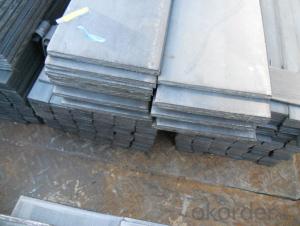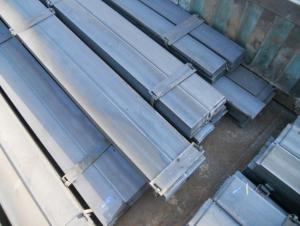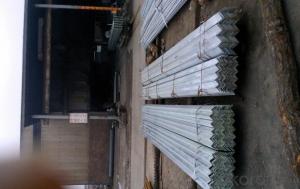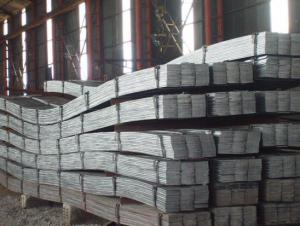high quality flat bar
- Loading Port:
- China Main Port
- Payment Terms:
- TT OR LC
- Min Order Qty:
- -
- Supply Capability:
- -
OKorder Service Pledge
OKorder Financial Service
You Might Also Like
Product Description:
Product Description:
Specification of Mild Steel Flat Bar
Commodity: Mild Steel Flat Bar
Standard: GB;JIS
Material: Q195-235;SS400
Brand name: FLATSPACE
Origin place: China
Thickness: 3mm-30mm
Width:20mm-200mm
Length: Max 12m
Certification: SGS/BV
Chemical composition of Q235
Alloy No | Grade | Element(%) | ||||
C
| Mn
| S
| P
| Si
| ||
Q235
|
B
|
0.12—0.20 |
0.3—0.7 |
≤0.045 |
≤0.045
|
≤0.3
|
Physical properties of Q235
Alloy No | Grade | Yielding strength point(Mpa) | Tensile strength (Mpa) | Elongation after fracture(%) | ||||||
Thickness (mm) | Thickness (mm) | |||||||||
≤16 | >16--40 | >40--60 | >60--100 |
| ≤16 | >16--40 | >40--60 | >60--100 | ||
≥ | ≥ | |||||||||
Q235 |
B |
235 |
225 |
215 |
205 |
375--500 |
26 |
25 |
24 |
23 |
Usage/Applications of Mild Steel Flat Bar
Widely used for construction, Machinery manufacturing, Iron tower steel structure, Shipbuilding; Steel grating, Staircase, Bridge, Viaduct, Railway spare parts, Boilers making etc.
Packaging & Delivery of Mild Steel Flat Bar
Packaging Details: The Mild Steel Flat Bars are packed in bundles and loaded in 20 feet/40 feet container, or shipped by bulk cargo ,also we can do as customer's requirements.
Delivery Details:30~45 days upon the receipt of buyer payment by T.T. or L/C.
Production Flow of Mild Steel Flat Bar
The Mild steel flat bar is made through three processes:
1.Feeding the material: Feeding the row material (the steel plate) to Slitting Line.
2.Slitting:The steel plate would be slitted into expected width by lengthways cutter.
3. Leveled and cutting: The plat bar would be ground into level by the grinder and then cut into required length
- Q: How do you prevent pitting or cracking on steel flat bars?
- To prevent pitting or cracking on steel flat bars, several measures can be taken. First and foremost, proper storage conditions should be ensured, with the bars kept in a dry and controlled environment to prevent exposure to moisture or humidity. Additionally, applying a protective coating, such as paint or a corrosion-resistant finish, can act as a barrier against environmental factors that may cause pitting or cracking. Regular maintenance and inspection are also crucial, as any signs of corrosion or damage should be addressed promptly to prevent further deterioration. Lastly, avoiding excessive stress or load on the bars during handling and usage can help minimize the risk of cracking.
- Q: What are the different methods of surface texturing for steel flat bars?
- Steel flat bars can be textured using various methods, each with its own benefits and applications. These methods allow for the creation of different textures and patterns on the bars, enhancing their appearance, grip, or functionality. Common techniques for surface texturing of steel flat bars include: 1. Shot blasting: By propelling small metal or abrasive particles onto the bars at high speeds, this method removes scale, mill scale, or rust, resulting in a clean and rough finish. 2. Sanding or grinding: Using abrasive tools like sandpaper or grinding wheels, material is manually removed from the bars' surface, creating textured finishes with patterns or grooves. 3. Knurling: This process involves rolling or pressing ridges or grooves onto the bars' surface, improving grip and preventing slipping, making it suitable for non-slip applications. 4. Acid etching: Chemical solutions selectively remove a thin layer of the steel's surface, creating precise and intricate textured patterns, including designs or logos. 5. Roller embossing: Bars are passed through rollers with engraved patterns, pressing the pattern onto the surface and creating various designs and textures for aesthetic appeal. 6. Laser texturing: Laser technology removes material from the surface, achieving precise and intricate patterns with high accuracy and repeatability. This method is ideal for decorative purposes or specialized applications that require precise texture control. Each method has its advantages and should be chosen based on the desired texture, application requirements, and cost-effectiveness. Selection depends on factors like intended use, desired appearance, functionality, and budget constraints.
- Q: Are steel flat bars available in custom sizes?
- Indeed, custom-sized steel flat bars can be obtained. Although standard sizes of steel flat bars are readily available in the market, numerous suppliers and manufacturers provide the opportunity to personalize the dimensions of flat bars according to specific demands. This grants customers the ability to acquire steel flat bars that are perfectly suited for their particular project requirements, whether it entails a distinct length, width, or thickness. The customization of steel flat bar sizes guarantees an accurate fit and maximum efficiency for a wide range of applications, encompassing construction, manufacturing, and fabrication.
- Q: What are the common safety precautions when working with steel flat bars?
- Some common safety precautions when working with steel flat bars include wearing appropriate personal protective equipment such as safety glasses, gloves, and steel-toed boots to protect against potential hazards. It is important to ensure the work area is clear of any obstructions or tripping hazards. Additionally, using proper lifting techniques and equipment is crucial to avoid strain or injury. It is also important to be cautious when operating any tools or machinery, following proper safety guidelines and procedures. Regular inspection and maintenance of equipment and tools should be conducted to ensure they are in good working condition. Lastly, having proper training and knowledge of handling steel flat bars can help prevent accidents and ensure a safe work environment.
- Q: What is the maximum thickness of a steel flat bar?
- The maximum thickness of a steel flat bar depends on various factors such as the manufacturing process, the desired application, and the specific type of steel being used. Generally, steel flat bars can range in thickness from a few millimeters to several inches. However, it is important to consult with manufacturers, engineers, or industry standards to determine the maximum thickness for a specific steel flat bar as it can vary depending on the intended use and structural requirements.
- Q: What is the difference between hot-rolled and cast steel flat bars?
- The main difference between hot-rolled and cast steel flat bars lies in the manufacturing process and the resulting properties of the two products. Hot-rolled steel flat bars are produced by heating a steel billet or ingot to a high temperature and then rolling it through a series of rollers to achieve the desired shape and dimensions. This process results in a product with a rougher surface finish and a slightly rounded edge. Hot-rolled steel flat bars are known for their malleability and ductility, making them suitable for a wide range of applications. They are commonly used in construction, manufacturing, and general fabrication due to their strength and versatility. On the other hand, cast steel flat bars are produced by pouring molten steel into a mold, allowing it to cool and solidify into the desired shape. This process results in a product with a smoother surface finish and sharp edges. Cast steel flat bars are typically harder and more brittle than hot-rolled steel flat bars, which makes them ideal for applications that require higher strength and wear resistance. They are commonly used in industries such as mining, agriculture, and machinery manufacturing, where durability and toughness are essential. In summary, the main differences between hot-rolled and cast steel flat bars lie in their manufacturing processes, resulting surface finishes, and mechanical properties. Hot-rolled steel flat bars are malleable, versatile, and have a rougher surface finish, while cast steel flat bars are harder, more brittle, and have a smoother surface finish. The choice between the two depends on the specific requirements of the application, such as strength, durability, and surface finish.
- Q: How do steel flat bars perform in high-humidity environments?
- Steel flat bars generally perform well in high-humidity environments, but their performance can be affected by certain factors. Steel is known for its strength, durability, and corrosion resistance, which makes it suitable for various applications. However, in high-humidity environments, the presence of moisture can accelerate the corrosion process, potentially causing rust and deterioration of the steel. To mitigate the effects of high humidity, steel flat bars can be coated with protective finishes or treated with corrosion-resistant coatings such as galvanization. These coatings create a barrier between the steel and the surrounding environment, preventing or slowing down the corrosion process. However, it is important to note that the effectiveness of these coatings can vary depending on the quality of the coating and the severity of the humidity. In extremely humid or corrosive environments, it may be necessary to use stainless steel flat bars, which have a higher resistance to corrosion. Regular maintenance and inspection are also crucial in high-humidity environments to identify any signs of corrosion or damage early on. This can involve cleaning the steel regularly, removing any accumulated moisture or debris, and applying additional protective coatings if necessary. Overall, while steel flat bars can perform well in high-humidity environments, it is essential to consider the specific conditions and take appropriate measures to ensure their long-term durability and performance.
- Q: What industries commonly use steel flat bars?
- Steel flat bars are commonly used in a wide range of industries due to their versatile nature and durability. Some of the industries that commonly use steel flat bars include construction, manufacturing, automotive, infrastructure, and engineering. In the construction industry, steel flat bars are used for various purposes such as support beams, frames, braces, and structural components in buildings and bridges. They provide strength and stability to structures, making them ideal for withstanding heavy loads and pressure. Manufacturing industries also rely on steel flat bars for fabricating machinery, equipment, and tools. Due to their malleability, steel flat bars can be easily shaped and machined to meet specific requirements, making them suitable for various manufacturing processes. The automotive industry utilizes steel flat bars in the production of vehicles, especially in the chassis and body frames. Steel flat bars provide the necessary strength and rigidity to withstand the stresses and strains experienced by automobiles, ensuring safety and durability. Infrastructure projects such as highways, railways, and airports also extensively use steel flat bars. These bars are used in the construction of beams, columns, and other structural elements, providing the necessary strength to support heavy loads and withstand environmental conditions. Engineering industries also heavily rely on steel flat bars for a wide range of applications. These bars are commonly used in the fabrication of machinery, equipment, and components that require strength, resilience, and versatility. They are also used in the construction of support structures, frames, and braces required in various engineering projects. In summary, the industries that commonly use steel flat bars include construction, manufacturing, automotive, infrastructure, and engineering. Their versatility, strength, and durability make them indispensable in these industries for various applications and projects.
- Q: Are steel flat bars suitable for making furniture?
- Yes, steel flat bars are suitable for making furniture. Steel is a strong and durable material that can withstand heavy weight and provide stability to furniture pieces. Steel flat bars can be used to create various furniture items such as tables, chairs, shelves, and frames. They offer a sleek and modern aesthetic and can be easily incorporated into different design styles. Additionally, steel is resistant to rust and corrosion, making it a long-lasting and low-maintenance option for furniture. Overall, steel flat bars provide the necessary strength, stability, and versatility required for furniture making.
- Q: What are the different types of steel alloys used in flat bars?
- Flat bars in the production process commonly use several different types of steel alloys. Carbon steel, stainless steel, alloy steel, and tool steel are among the most popular choices. 1. Carbon Steel: The most frequently used steel alloy for flat bars is carbon steel. Its composition primarily consists of iron and carbon, with small amounts of other elements. Known for its strength and durability, carbon steel is suitable for a wide range of applications. 2. Stainless Steel: By adding chromium to carbon steel, stainless steel is created, enhancing its resistance to corrosion. Flat bars made of stainless steel are highly resistant to rust and staining, making them ideal for applications that involve exposure to moisture or chemicals, such as in the food industry or outdoor structures. 3. Alloy Steel: Alloy steel is produced by incorporating various elements like manganese, nickel, or chromium into carbon steel. These additional elements improve the strength, hardness, and resistance to wear and tear of flat bars. Alloy steel flat bars are commonly used in applications that require high strength, such as construction equipment or machinery parts. 4. Tool Steel: Tool steel is specifically designed to possess high hardness, wear resistance, and toughness. It is commonly used in the production of cutting tools, dies, and molds. Tool steel flat bars often comprise a combination of elements like tungsten, vanadium, or molybdenum to achieve the desired properties for specific applications. Each steel alloy type possesses unique properties and advantages, making them suitable for different applications. The selection of a steel alloy for flat bars depends on factors like the required strength, corrosion resistance, and overall performance needed for the specific application.
Send your message to us
high quality flat bar
- Loading Port:
- China Main Port
- Payment Terms:
- TT OR LC
- Min Order Qty:
- -
- Supply Capability:
- -
OKorder Service Pledge
OKorder Financial Service
Similar products
Hot products
Hot Searches
Related keywords




























